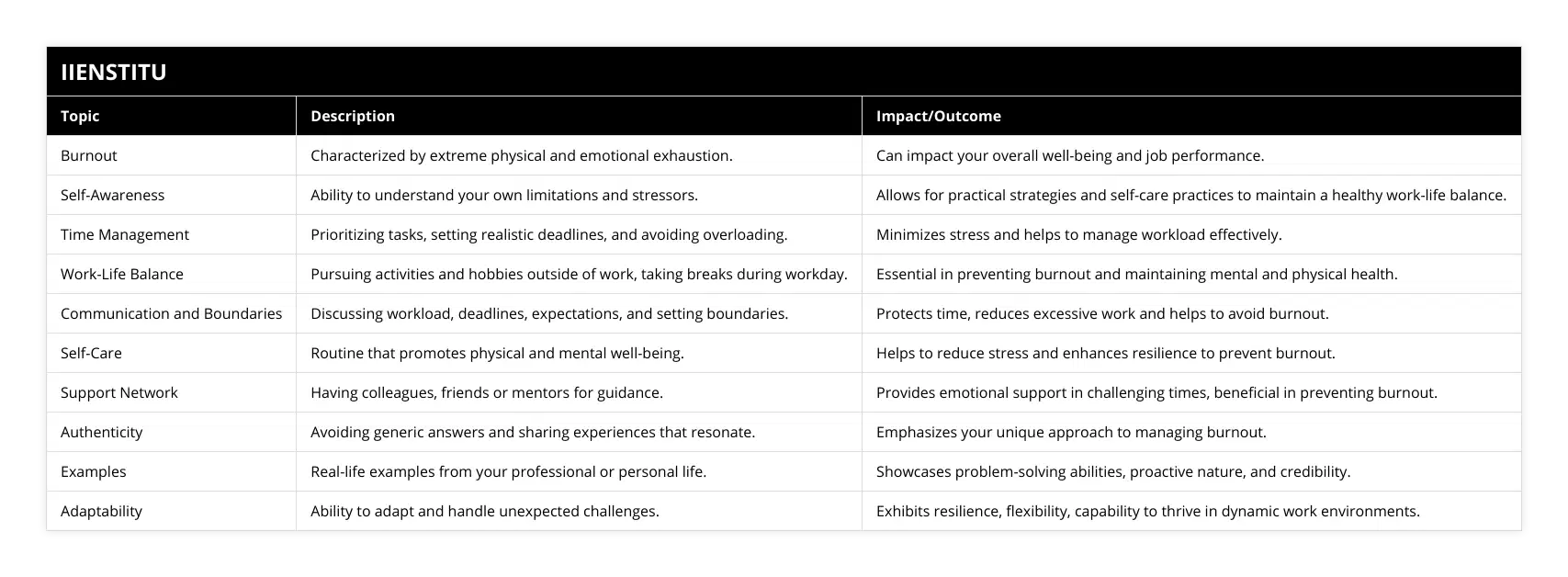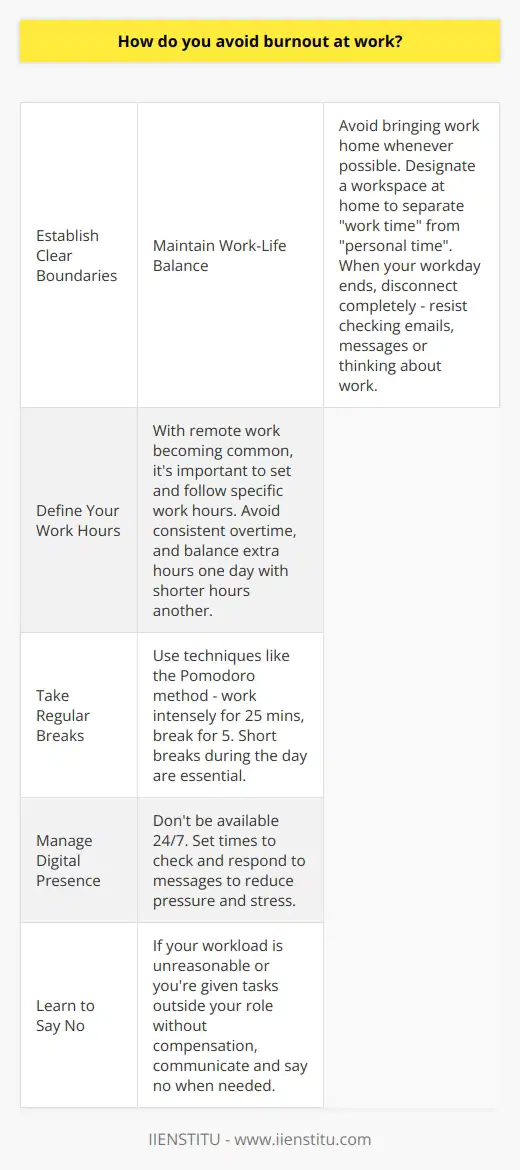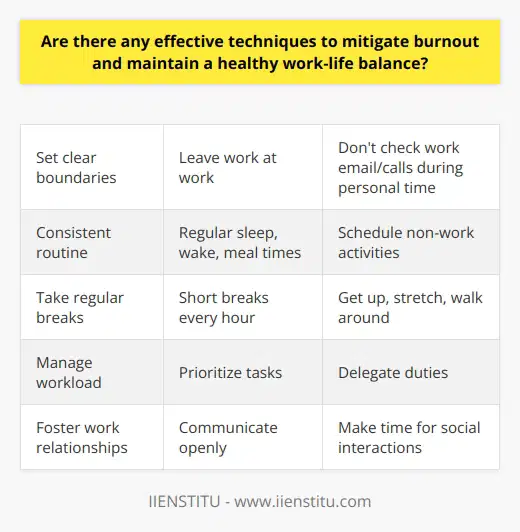
In today's fast-paced and demanding work environment, it's not uncommon for individuals to experience burnout. Burnout, characterized by extreme physical and emotional exhaustion, can greatly impact your well-being and job performance. That is why employers often ask candidates in interviews about strategies to avoid burnout at work.
In this article, we will explore why this question is asked, the purpose it serves, the relevant interview levels, the expected answers from candidates, and some effective strategies to combat burnout.
Why is this interview question asked: How Do You Avoid Burnout at Work?
It's crucial for employers to ensure that they hire individuals who can effectively manage their workload and maintain their well-being. By asking this question, employers aim to identify candidates who possess self-awareness, resilience, and a healthy work-life balance.
It shows they value the emotional and physical well-being of their employees and are invested in creating a positive work culture.
The purpose of the question:
The purpose of this question is two-fold. Firstly, it allows interviewers to assess the candidate's level of self-awareness and their understanding of the importance of avoiding burnout.
Secondly, it provides the opportunity for candidates to showcase their coping mechanisms and stress management skills, indicating their ability to maintain productivity and contribute to a healthy work environment.
Related Course: Stress Management Course
Interview Question: What Time Management Technique Starts Your Day?
Interview Question: How Do You Balance Personal and Work Time Management?
Interview Question: Measuring Performance with Supply Chain KPIs
At what interview level is it asked?
This question can be asked at various interview levels, but it is more commonly encountered in mid to senior-level positions. As candidates progress in their careers, the responsibilities and expectations increase, increasing the likelihood of experiencing burnout. Employers are keen to hire individuals who have the experience and strategies to manage their well-being effectively.
İnterview Question How Have Teams Enhanced Your Problem Solving
How To Answer Job İnterview Question On Recovering Failed Time Management Plan
What kind of answer is expected from the candidate?
When answering this question, candidates must demonstrate their understanding of their own limitations and stressors, as well as their ability to implement effective strategies to maintain a healthy work-life balance.
Employers expect candidates to present both self-care practices and practical methods for overcoming workplace stress. A successful answer should showcase proactive approaches to manage workload, set boundaries, and foster a positive mindset.
Possible answers to consider:
Self-awareness: Start by acknowledging the signs of burnout and understanding your personal triggers. Identifying your stressors will allow you to address them more effectively and take preventive measures.
Time management: Employers appreciate candidates who can Prioritize Tasks, delegate when necessary, and avoid overloading themselves. Effective Time Management Techniques such as using productivity tools, setting realistic deadlines, and breaking down tasks can help minimize stress.
Work-life balance: Maintaining a healthy work-life balance is essential to prevent burnout. Seek activities and hobbies outside of work that bring you joy and relaxation. Designate specific time for self-care and ensure you take regular breaks during the workday.
Communication and boundaries: Constructive communication with your supervisors and colleagues plays a vital role in avoiding burnout. Openly discuss your workload, deadlines, and expectations. Set boundaries to protect your time and avoid excessive work or being constantly 'on-call.'
Self-care routines: Implement self-care rituals that promote physical and mental well-being. Exercise regularly, practice mindfulness or meditation, get enough sleep, and eat healthily. These practices can significantly reduce stress and enhance resilience.
Support network: Cultivate a supportive network of colleagues, friends, or mentors who can provide guidance and lend a listening ear during challenging times. Sharing experiences and seeking advice from others who have faced similar situations can be incredibly beneficial.
Related Course: Time Management Course Online
What to consider when answering:
Be authentic: Avoid giving generic answers and instead focus on sharing experiences and strategies that genuinely resonate with you. Interviewers appreciate sincerity and want to see your unique approach to managing burnout.
Provide examples: Whenever possible, illustrate your answers with real-life situations from your professional or personal life. This helps showcase your problem-solving abilities and demonstrates your proactive nature.
Highlight adaptability: Demonstrating your capacity to adapt to changing circumstances and handle unexpected challenges proves your resilience and flexibility. Employers value candidates who can thrive in dynamic work environments.
In today's work culture, avoiding burnout is crucial for maintaining productivity, well-being, and overall job satisfaction. Organizations seek candidates who understand the significance of self-care, set healthy boundaries, and exhibit resilience.
By preparing effective answers to this Interview Question, you can demonstrate your commitment to maintaining your well-being and contribute positively to your future workplace. Remember, burnout prevention is an ongoing process that requires continuous self-assessment and the implementation of effective strategies.
Employee Well-being Programs and Initiatives
Effective Time and Stress Management Techniques
Work-life Balance Strategies
Similar interview questions:
Multiple choice: Which of the following strategies can help mitigate burnout in the workplace?
a) Increasing workload
b) Working longer hours
c) Taking regular breaks
d) Ignoring personal well-beingTrue or False: Engaging in regular physical exercise is an effective way to prevent burnout at work.
Fill in the blank: One effective way to avoid burnout is to prioritize ________ and set boundaries in the workplace.
Short answer: What steps can individuals take to reduce burnout in their professional lives
Matching: Match the following key factors to their corresponding methods of preventing workplace burnout:
i) Establishing a support network a) Taking vacation time
ii) Balancing workload b) Practicing mindfulness techniques
iii) Setting clear boundaries c) Seeking managerial supportEssay: Discuss the importance of a positive work-life balance in preventing burnout, providing concrete examples or personal experiences.
Ranking: Rank the following strategies to avoid burnout in order of effectiveness, with 1 being the most effective and 4 being the least effective:
i) Incorporating stress-management techniques into the daily routine
ii) Adopting a healthy lifestyle
iii) Seeking professional help or counseling
iv) Identifying and addressing sources of workplace stressOpinion: In your opinion, what role does organizational culture play in preventing employee burnout? Provide reasons to support your answer.
Scenario-based: Imagine you have a colleague who appears to be on the verge of burnout. How would you approach and support them in managing their work-related stress?
Multiple answer: Which of the following factors contribute to burnout and should be actively monitored and minimized in the workplace? Select all that apply:
a) Excessive workload
b) Lack of autonomy
c) Poor communication channels
d) Encouraging work-life balance

Frequently Asked Questions
How do you avoid burnout at work?
1 - Establish Clear Boundaries
a. Work-Life Balance: Avoid taking work home. If possible, have a dedicated workspace even at home to differentiate "work time" from "personal time". When your workday ends, truly disconnect. This means resisting the urge to check work emails, messages, or think about work-related tasks.
b. Set Specific Work Hours: Especially with remote work becoming more common, it's essential to establish and stick to specific work hours. Avoid working overtime consistently, and if you must work extra hours one day, consider balancing it out with shorter hours another day.
c. Take Regular Breaks: During the workday, ensure you take short breaks. Techniques like the Pomodoro Technique can be helpful, where you work intensely for 25 minutes and then take a 5-minute break.
d. Manage Your Digital Presence: Avoid being available 24/7. Set specific times to check and respond to emails or messages. This avoids the constant pressure of immediate responses and reduces stress.
e. Learn to Say No: If your workload is too much or if you're being given tasks outside of your role without additional compensation or time, it's essential to communicate and sometimes say no for the sake of your well-being.
2 - Establish Clear Priorities
a. Prioritize Tasks: Use tools or techniques like the Eisenhower Box or the ABCD method to prioritize tasks. This helps in identifying which tasks are urgent and essential, which can wait, and which can be delegated or eliminated.
b. Delegate When Possible: Understand that you don't need to do everything yourself. If there are tasks that can be done by others, delegate. This not only reduces your workload but can also be an opportunity for team growth.
c. Manage Time Effectively: Use time management tools and techniques like time blocking, to-do lists, or apps like Trello or Asana to keep track of tasks and manage your time efficiently.
d. Avoid Multitasking: Contrary to popular belief, multitasking can reduce productivity and increase stress. Focus on one task at a time and see it through before moving onto the next.
e. Set Realistic Expectations: Understand that perfection isn’t always achievable. Instead, aim for excellence and set realistic goals for yourself and others.
Additional tips:
Self-Care: Prioritize activities that relax and rejuvenate you, whether it's reading, exercising, meditating, or spending time with loved ones.
Seek Feedback: Regularly check in with supervisors or peers about your performance. Knowing you're on the right track can alleviate stress.
Stay Organized: Keep your workspace tidy, and your tasks organized. A cluttered environment can contribute to feelings of overwhelm.
Professional Development: Attend workshops or webinars on stress management, time management, or any other topic that might help you manage your workload and emotions better.
Seek Support: If you feel overwhelmed, don't hesitate to talk to someone, whether it's a supervisor, colleague, or mental health professional. Sometimes, discussing your feelings can provide clarity and relief.
By implementing the above measures and continually monitoring and adjusting as needed, you can significantly reduce the risk of burnout and ensure a healthier, more balanced work life.

What strategies can be implemented to prevent burnout at the workplace?
Implementing strategies to prevent workplace burnout is essential for maintaining employee well-being and productivity. Some effective approaches include setting realistic work expectations, promoting work-life balance, encouraging social support, providing opportunities for learning and development, and recognizing and rewarding employee achievements.
One strategy to prevent burnout is to establish realistic work expectations. Clearly communicate deadlines and goals to employees, ensuring they are manageable and achievable within regular working hours. This prevents overwhelming workloads that contribute to burnout.
Promoting work-life balance is another effective approach. Encourage employees to take regular breaks, utilize vacation days, and engage in activities outside of work. This helps maintain a healthy work-life balance and prevent burnout.
Encouraging social support is crucial in preventing burnout. Foster a supportive work environment where colleagues can communicate and collaborate effectively. This reduces feelings of isolation and provides a buffer against burnout.
Providing opportunities for learning and development is also beneficial. Engage employees in skill-building workshops, training programs, or conferences. This helps them stay motivated and engaged in their work, reducing the risk of burnout.
Recognizing and rewarding employee achievements is an effective way to prevent burnout. Regularly acknowledge and appreciate employees' efforts and accomplishments. This instills a sense of value and satisfaction, which can boost morale and reduce burnout.
To summarize, implementing strategies such as setting realistic work expectations, promoting work-life balance, encouraging social support, providing learning opportunities, and recognizing employee achievements are effective ways to prevent burnout in the workplace.

Are there any effective techniques to mitigate burnout and maintain a healthy work-life balance?
Yes, there are effective techniques to mitigate burnout and maintain a healthy work-life balance. One technique is setting clear boundaries between work and personal life. By establishing a schedule and sticking to it, individuals can create time for leisure and relaxation.
Regular breaks throughout the workday can also alleviate burnout and enhance productivity. Engaging in regular physical exercise helps reduce stress and promotes overall well-being. Maintaining a social support network and seeking support from colleagues, friends, or family can help alleviate work-related stress.
Implementing effective time management strategies and prioritizing tasks can prevent overwhelming workloads. Promoting a positive workplace culture that values work-life balance is also crucial in preventing burnout.



